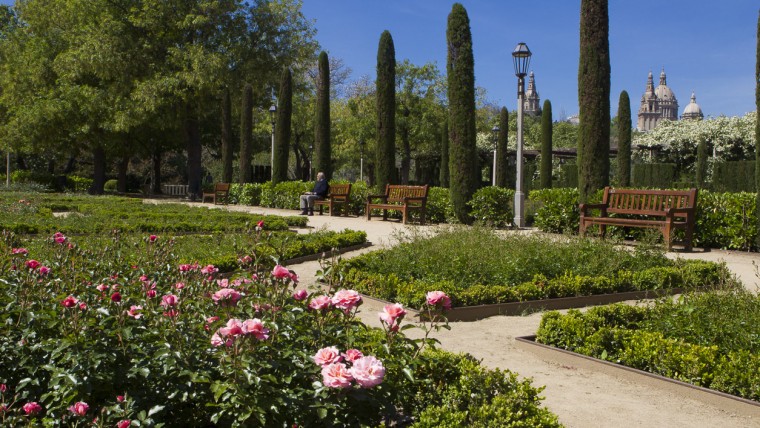
These gardens, which began life as a rose garden, are one of several green spaces created on Montjuïc for the 1929 International Exposition. An old quarry allowed the construction of an amphitheatre that now hosts many of the Barcelona Grec Festival performances every summer. It is a sunny spot, with geometric flowerbeds, pergolas and terraces, from where visitors can admire the landscaped mountain and the city.
As you walk up Passeig de Santa Madrona, you will encounter a large, stone, imperial staircase that rises up either side of a wall. This is the main entrance to the gardens. From here you can see some of their main features: the pergola, the old pavilion and the sloping trimmed hedges with tall trees behind them.

History
Jardins del Teatre Grec is the current name of the Roserar Amargós, a rose garden that used to be part of a garden complex built on Montjuïc for the 1929 Barcelona International Exposition. This was named after the first architect to landscape Montjuïc, Amargós, but the gardens were designed by the French civil engineer, Jean-Claude Nicolas Forestier.
The main purpose of the Roserar Amargós was to connect the large Plaça del Solstici – originally part of the Jardins de Laribal but now the site of the Fundació Miró – to the lower part of Passeig de Santa Madrona and the 1929 International Exposition’s buildings located in that area, bridging a difference of 44 metres in ground levels.
After 1979, when democracy returned to Barcelona City Council, the site regained its artistic and landscape splendour, becoming the main venue for Barcelona’s summer festival: the Grec Festival.

Art and Architecture
The amphitheatre in these gardens, which gives rise to their current name, was built according to the traditional Greek model. It was designed by the architect Ramon Reventós and made the most of the slope of the old “Machinet” quarry, which had been worked by excavating the earth before a huge wall of extremely hard stone just where Montjuïc mountain starts to rise.
As for the building that houses the bar restaurant during the theatre season, this was originally the Music Pavilion for the 1929 International Exposition.
-
- Phone number
- Tel.: 010
-
- Titularity
- Public center
- Address:
- Pg Santa Madrona, 38
- Districte:
- Sants-Montjuïc
- Neighborhood:
- el Poble-sec
- City:
- Barcelona
Timetable
| Periode | Dies | Hores |
|---|---|---|
Horari d'hivern de l'1 de novembre al 31 de març |
Cada dia | de 08.00 h a 19.00 h |
Horari d'estiu de l'1 d'abril al 31 d'octubre |
de 08.00 h a 21.00 h |
aproximada, en funció de
l'horari solar (tanquen
quan es fa fosc, al capvespre)


